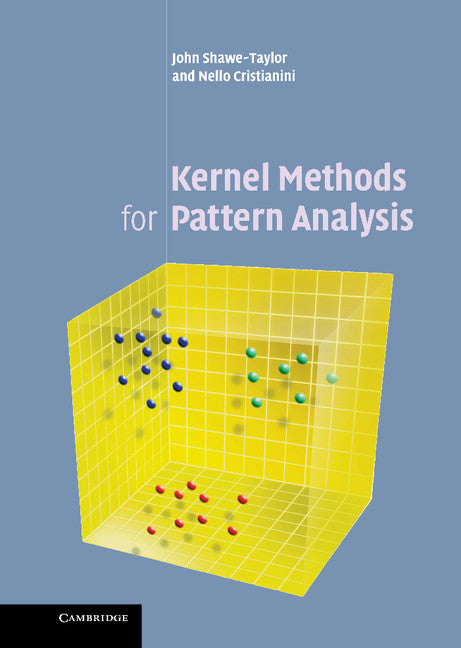Freshly Printed - allow 6 days lead
Couldn't load pickup availability
Kernel Methods for Pattern Analysis
A unique account of developing topic in data mining and machine learning.
John Shawe-Taylor (Author), Nello Cristianini (Author)
9780521813976, Cambridge University Press
Hardback, published 28 June 2004
478 pages, 6 tables
24.9 x 17 x 3 cm, 1 kg
' … I enjoyed reading this book and am happy about is addition to my library as it is a valuable practitioner's reference. I especially liked the presentation of kernel-based pattern analysis algorithms in terse mathematical steps clearly identifying input data, output data, and steps of the process. The accompanying Matlab code or pseudocode is al extremely useful.' IAPR Newsletter
Kernel methods provide a powerful and unified framework for pattern discovery, motivating algorithms that can act on general types of data (e.g. strings, vectors or text) and look for general types of relations (e.g. rankings, classifications, regressions, clusters). The application areas range from neural networks and pattern recognition to machine learning and data mining. This book, developed from lectures and tutorials, fulfils two major roles: firstly it provides practitioners with a large toolkit of algorithms, kernels and solutions ready to use for standard pattern discovery problems in fields such as bioinformatics, text analysis, image analysis. Secondly it provides an easy introduction for students and researchers to the growing field of kernel-based pattern analysis, demonstrating with examples how to handcraft an algorithm or a kernel for a new specific application, and covering all the necessary conceptual and mathematical tools to do so.
Preface
Part I. Basic Concepts: 1. Pattern analysis
2. Kernel methods: an overview
3. Properties of kernels
4. Detecting stable patterns
Part II. Pattern Analysis Algorithms: 5. Elementary algorithms in feature space
6. Pattern analysis using eigen-decompositions
7. Pattern analysis using convex optimisation
8. Ranking, clustering and data visualisation
Part III. Constructing Kernels: 9. Basic kernels and kernel types
10. Kernels for text
11. Kernels for structured data: strings, trees, etc.
12. Kernels from generative models
Appendix A: proofs omitted from the main text
Appendix B: notational conventions
Appendix C: list of pattern analysis methods
Appendix D: list of kernels
References
Index.
Subject Areas: Pattern recognition [UYQP], Artificial intelligence [UYQ], Data capture & analysis [UNC]


